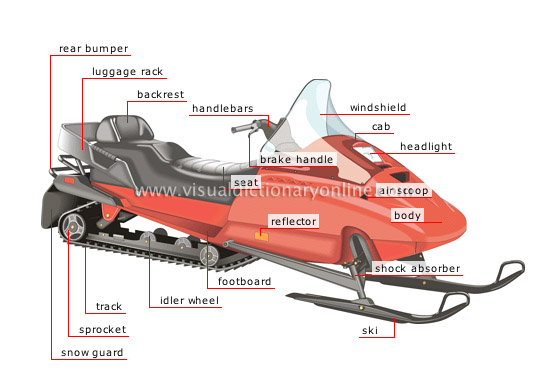snowmobile
Motorized vehicle with a track and skis for moving rapidly on snow; some snowmobiles reach speeds of 125 mph.
ski 
Relatively wide blade that is attached to the front of the snowmobile and allows it to glide on snow; the skis are steered by the handlebars.
air scoop 
Opening for letting the outside air in to cool the engine.
body 
Snowmobile structure that houses and protects the mechanical components.
shock absorber 
Cylindrical device that is attached to the ski and coupled with a spring; it absorbs shocks caused by unevenness on the snow.
reflector 
Device that reflects light back to its source to make the snowmobile visible at night.
snow guard 
Rubber or plastic part attached to the rear of the track that protects against flying snow.
sprocket 
Wheel with teeth, which make successive contact with the track teeth to transmit its motion and propel the snowmobile.
track 
Belt into which the sprockets mesh; it provides the snowmobile’s traction.
idler wheel 
Wheel that keeps the track taut.
headlight 
Lamp on the front of the vehicle to light up the space in front.
cab 
Lidlike part of the body that covers and protects the engine.
windshield 
Resistant glass and plastic panel that protects the operator from the wind and inclement weather.
handlebars 
Device made up of two handles that the operator manipulates to steer the snowmobile.
brake handle 
Lever the operator activates to slow down or stop the snowmobile.
seat 
Seat, usually made of leather, on which the operator sits; a passenger can sit behind the operator.
backrest 
Part supporting the passenger’s lower back.
luggage rack 
Structure attached to the rear of the snowmobile for transporting baggage.
rear bumper 
Malleable component attached to the rear of the snowmobile to dampen impact in the event of collision; it also acts as a handle for moving the snowmobile.









